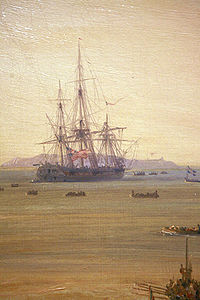 HMS Iphigenia at the Battle of Grand Port
| |
| History | |
|---|---|
| Name | HMS Iphigenia |
| Namesake | Iphigeneia |
| Laid down | 1805 |
| Launched | 26 April 1808 |
| Captured | at the Battle of Grand Port, late August 1810 |
| Fate | captured |
| Name | Iphigénie |
| Acquired | August 1810 by capture |
| Captured | December 1810 |
| Name | HMS Iphigenia |
| Acquired | December 1810 by capture |
| Fate | Broken up May 1851 |
| General characteristics | |
| Class and type | Perseverance-class fifth-rate frigate |
| Tons burthen | 870, or 876[1] (bm) |
| Propulsion | Sail |
| Complement | 264 |
| Armament |
|
| Armour | Timber |
HMS Iphigenia was a Royal Navy 36-gun Perseverance-class fifth-rate frigate. She was built at Chatham Dockyard by Master Shipwright Robert Seppings.
The French captured her at the debacle of Grand Port and in their service she participated in the capture of several British vessels. The British recaptured her and she served in the West Africa squadron (or "Preventative Squadron"), combating the slave trade. She was broken up in 1851 after serving for many years as a training ship.